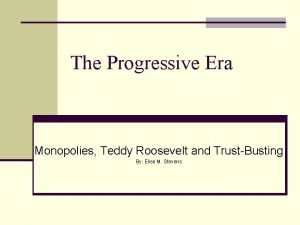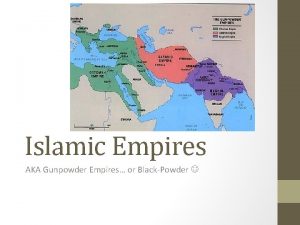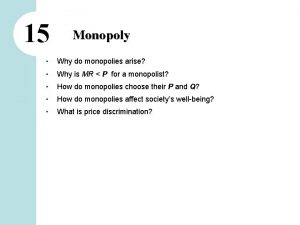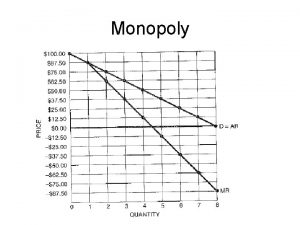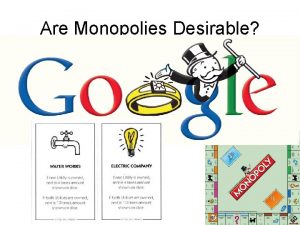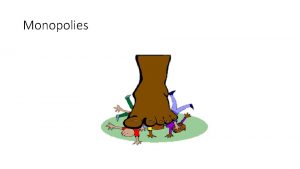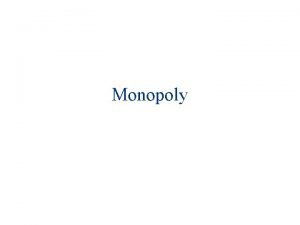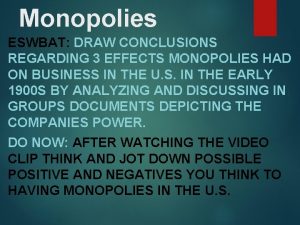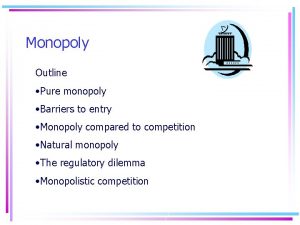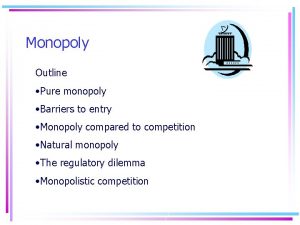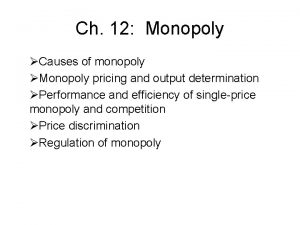Monopoly 1 Why Monopolies Arise Monopoly Firm that



















- Slides: 19

Monopoly 1

Why Monopolies Arise • Monopoly – Firm that is the sole seller of a product without close substitutes – Price maker • Barriers to entry – Monopoly resources – Government regulation – The production process 2

Why Monopolies Arise • Government regulation – Government gives a single firm the exclusive right to produce some good or service – Government-created monopolies • Patent and copyright laws • Higher prices • Higher profits 3

Why Monopolies Arise • Monopoly resources – A key resource required for production is owned by a single firm – Higher price • The production process – A single firm can produce output at a lower cost than can a larger number of producers 4

Why Monopolies Arise • Natural monopoly – A single firm can supply a good or service to an entire market • At a smaller cost than could two or more firms – Economies of scale over the relevant range of output 5

Economies of Scale as a Cause of Monopoly Costs Average total cost 0 Quantity of output 6

Production and Pricing Decisions • Monopoly – Price maker – Sole producer – Downward sloping demand • Market demand curve • Competitive firm – Price taker – One producer of many – Demand – horizontal line (Price) 7

Demand Curves for Competitive and Monopoly Firms (a) A Competitive Firm’s Demand Curve Price (b) A Monopolist’s Demand Curve Price Demand 0 Quantity of output 8

Production and Pricing Decisions • A monopoly’s revenue – Total revenue = price times quantity – Average revenue • Revenue per unit sold • Total revenue divided by quantity – Marginal revenue, MR < P • Revenue per each additional unit of output • Change in total revenue when output increases by 1 unit • Can be negative 9

A Monopoly’s Total, Average, and Marginal Revenue 10

Production and Pricing Decisions • Increase in quantity sold – Output effect • Q is higher • Increase total revenue – Price effect • P is lower • Decrease total revenue • Because MR < P – MR curve – is below the demand curve 11

Demand Marginal-Revenue Curves for a Monopoly Price $11 10 9 8 7 6 5 4 3 2 1 0 -1 -2 -3 -4 Demand (average revenue) 1 2 3 4 5 6 7 8 Quantity of water Marginal revenue 12

Production and Pricing Decisions • Profit maximization – If MR > MC – increase production – If MC > MR – produce less – Maximize profit • Produce quantity where MR=MC • Intersection of the marginal-revenue curve and the marginal-cost curve • Price – on the demand curve 13

Profit Maximization for a Monopoly Costs and Revenue Marginal cost B Monopoly price Average total cost A Demand Marginal revenue 0 Q 1 QMAX Q 2 Quantity 14

Production and Pricing Decisions • Profit maximization – Perfect competition: P=MR=MC • Price equals marginal cost – Monopoly: P>MR=MC • Price exceeds marginal cost • A monopoly’s profit – Profit = TR – TC = (P – ATC) ˣ Q 15

The Monopolist’s Profit Costs and Revenue Marginal cost B Monopoly E price Average total cost Monopoly profit Demand Average total cost D C Marginal revenue 0 QMAX Quantity 16

The Welfare Cost of Monopolies • Monopoly – Produce quantity where MC = MR – Produces less than the socially efficient quantity of output – Charge P>MC – Deadweight loss • Triangle between the demand curve and MC curve 17

The Inefficiency of Monopoly Costs and Revenue Marginal cost Deadweight loss Monopoly price Demand Marginal revenue 0 Monopoly quantity Efficient quantity Quantity 18

The Welfare Cost of Monopolies • The monopoly’s profit: a social cost? – Monopoly - higher profit – Social loss = Deadweight loss • From the inefficiently low quantity of output 19
 Why monopoly arise
Why monopoly arise Progressive era monopolies
Progressive era monopolies Why do territorial conflicts arise among religious groups
Why do territorial conflicts arise among religious groups Why might fishing disputes arise in the region
Why might fishing disputes arise in the region Pictures
Pictures Phân độ lown
Phân độ lown Block nhĩ thất độ 2 mobitz 1
Block nhĩ thất độ 2 mobitz 1 Thơ thất ngôn tứ tuyệt đường luật
Thơ thất ngôn tứ tuyệt đường luật Thơ thất ngôn tứ tuyệt đường luật
Thơ thất ngôn tứ tuyệt đường luật Chiến lược kinh doanh quốc tế của walmart
Chiến lược kinh doanh quốc tế của walmart Tìm vết của đường thẳng
Tìm vết của đường thẳng Con hãy đưa tay khi thấy người vấp ngã
Con hãy đưa tay khi thấy người vấp ngã Tôn thất thuyết là ai
Tôn thất thuyết là ai Gây tê cơ vuông thắt lưng
Gây tê cơ vuông thắt lưng Sau thất bại ở hồ điển triệt
Sau thất bại ở hồ điển triệt Describe the conditions under which new species may arise.
Describe the conditions under which new species may arise. How to arise and shine
How to arise and shine How did the ottoman safavid and mughal empires arise
How did the ottoman safavid and mughal empires arise Stick past
Stick past Oh church arise
Oh church arise

